March 26 - April 18, 2005
To Return to Home Page at any time,
use Browser's "Previous Page"
Wales may not be as exotic a destination as some but we were looking for a not-too-difficult, DIY trip. This one easily satisfied our itch to know what wonders were to be found in southern and central Wales. Although Britain is an expensive destination, especially for Americans right now, by “doing-it-ourselves” the total cost was no more than our Eastern Europe trip last year; both about 23 days long.
When we hear complaints about $2 per gallon gasoline in the US, we can’t help wincing a bit because that price is a bargain compared to what the British pay. The cheapest unleaded over there costs well over $6 per gallon. 70% of that cost is government tax. One British friend confided that he thought their government was trying to reduce the number of cars on the road by making petrol cost-prohibitive. By comparison, the average state plus federal gas tax here is about 21% of the price we pay.
We were delighted with the contrast between the still-dormant fields of PA, MD and northern VA when we left and the burst of springtime color in England and Wales. Most plentiful were daffodils, forsythia and gorse --- they seemed to be everywhere. Complementing these were tulips, flowering blackthorn bushes and cherry and magnolia trees, all decorating deeply green fields. On top of that, many houses in Wales were painted or accented with eye-catching, pastel colors.
Choosing to drive, our route covered most parts of south and central Wales.
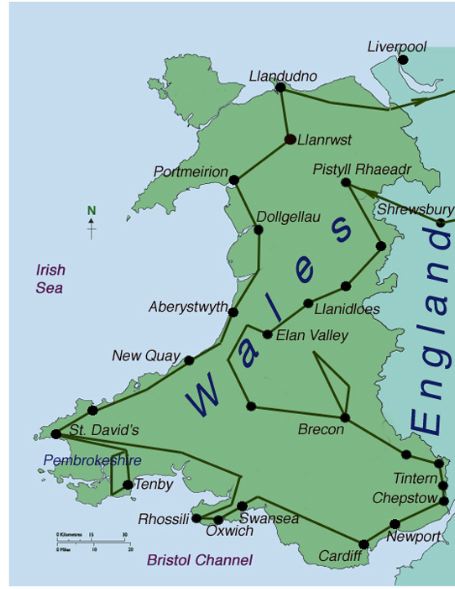
Although we couldn’t see everything, we seriously scratched the surface.
Shrewsbury, England, was our first overnight stop.
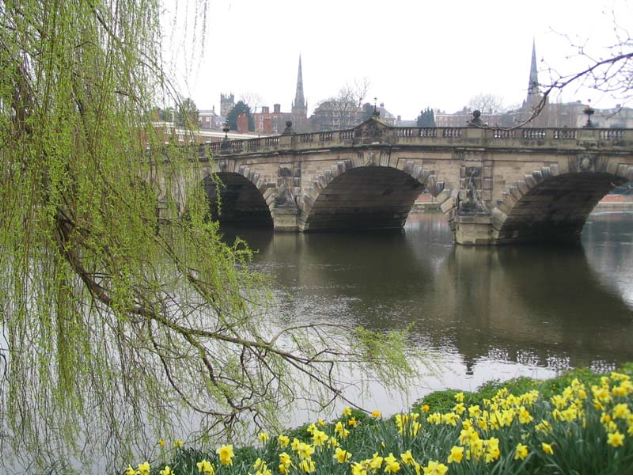
This old town is almost an island enclosed by a great loop of the Severn River. In medieval times, Shrewsbury grew wealthy as a center of the wool trade. Even today, its past grandeur is evident in many handsome, timber-framed buildings found along colorful streets like Butcher Row and Wyle Cop.
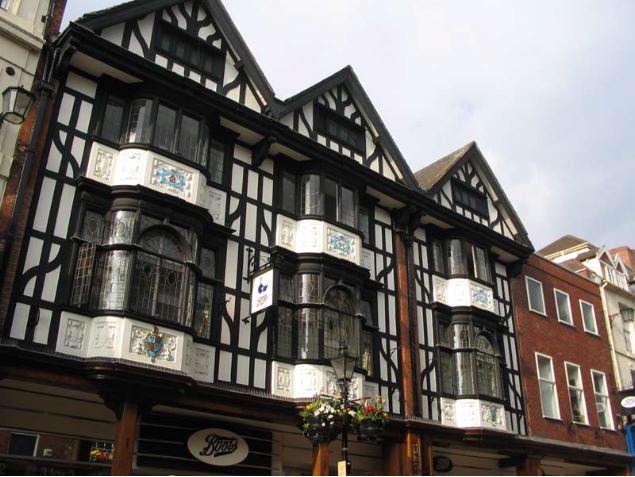
After a memorable Easter service in Shrewsbury’s Cathedral, a short drive west took us into Wales and to the highest waterfall in England or Wales.
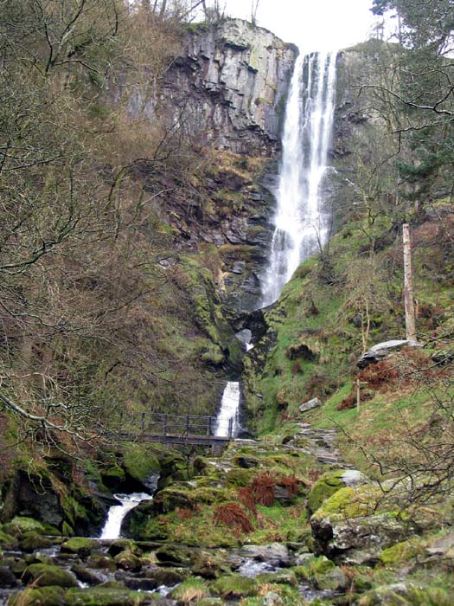
Pistyll Rhaeadr, as it’s called, drops 240 feet in several beautiful plunges with a natural arch between its first and second fall. On our maps it seemed to be out in the middle of nowhere but, judging from the hikers and campers assembled at its base, it is well known locally.
Throughout our two-week stay in Wales, we chose B&B’s for overnight accommodation. Although the price we paid was fairly uniform at 50 pounds for two persons, the quality was quite variable, as you might expect. The best we encountered for that price was the Grandstand B&B near Llanidloes. What a beautiful place! If only the weather had been better when we were there, it would have been perfect!
Near the Grandstand in the little town of Llanidloes, we stumbled upon one of those rare, free-standing Tudor market halls. (I mean, how many of those have you ever seen?) Fearful that this one’s collapse might be imminent, I bravely steadied it while Patty played photographer.

These days, the Elan Valley in the Welsh hills west of Birmingham, England, is a peaceful nature reserve with three striking reservoirs. The dams impounding this water were built in the 1890’s to provide for Birmingham’s needs. Of the 100 or so residents forced to move out of the valley, it is rather incredible that only landowners were reimbursed! Not a project to warm Welsh hearts, nevertheless, today this is an area of outstanding beauty.

Moreover, the stored water and generated electricity are consumed in Wales as well as in the Birmingham area. Unlike modern dams, decoration was seen as an integral part of the design. Here’s an example:
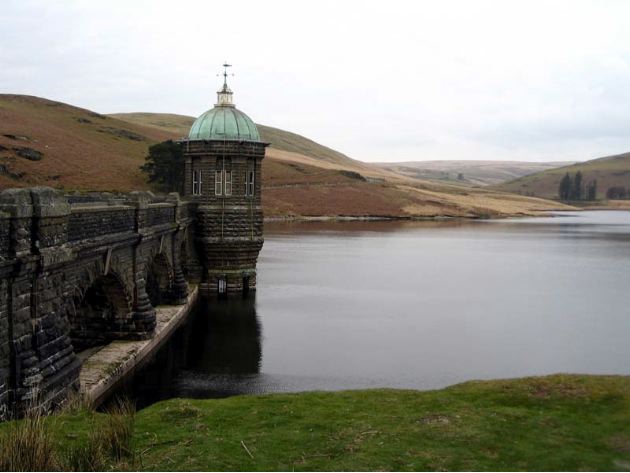
None of these dams have spillways per se; instead, when the water level exceeds the height of the dam, the water just spills over the top, creating a Niagara-like scene (which would have been awesome to view). In the 1950’s a fourth --- even bigger --- dam went into operation in the nearby Claerwen Valley.
The Brecon Beacons National Park should have been one of the highlights of our trip so we scheduled two full days in the town of Brecon. Unfortunately, a persistent rain fell throughout those two days. Not only were the high peaks of the Park hidden by clouds, even the hills just outside Brecon were invisible. With brollies ever overhead, we thoroughly explored the handsome town of Brecon, waiting for the precipitation to end. Our only hike out of town was a sodden trek along the canal and back to town by the muddy banks of the Usk River --- good exercise to be sure but offering limited photo opportunities. Happily, while the rainfall was still light, I was able to capture this bright scene on the Monmouthshire & Brecon Canal.
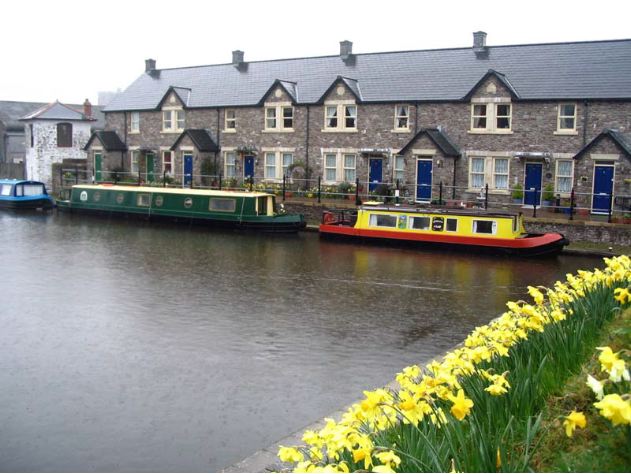
We looked forward to visiting the ruins of Tintern Abbey near Chepstow because of our fondness for Yorkshire’s serene and lovely Fountains Abbey. Indeed, we expected Tintern to be very similar to Fountains since both were Cistercian Abbeys, one founded in 1131, the other in 1132; and both were built in remote river valleys. Structurally, there are many similarities. However, for today’s visitor, Tintern lacks the quiet beauty of Fountains due to the proximity of a highway and town. Fountains is totally isolated from motorized traffic and includes (as of the 18th century) an attractive and spacious water garden. So, though we were somewhat disappointed with Tintern’s neighborhood, we’re glad that our favorite is so close to Harrogate. Had we never been to Fountains, there is no question we would have been most impressed with Tintern --- easy to understand when you view this photo of Patty inside Tintern Abbey, providing you an idea of its scale:
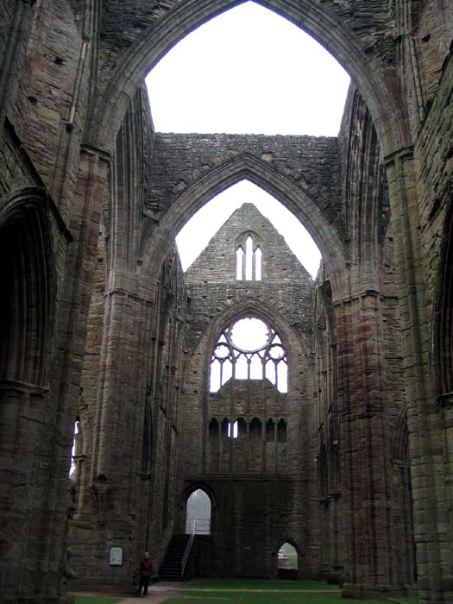
The Newport Transporter Bridge wouldn’t be everyone’s choice for a prime attraction but it was this curious piece of Edwardian engineering that brought us to Newport.
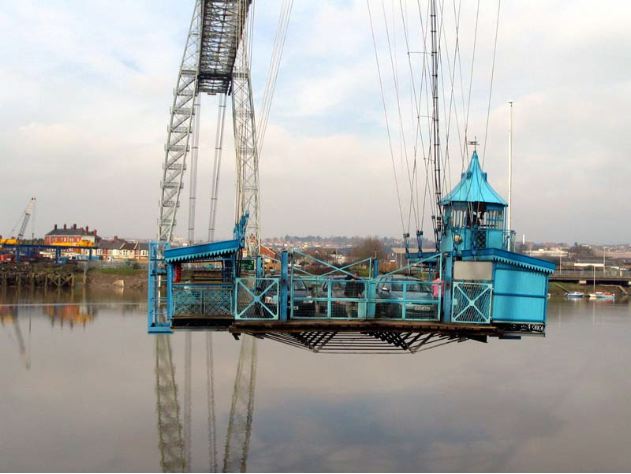
This remarkable stucture was built in 1906 to carry traffic across a river above high-masted ships. It swings up to six cars at a time in a gondola suspended from a 4-legged gantry. “Swing” may be a poor choice of words because we felt no sway at all as we, our car and five others were swiftly transported across. It was fun to see the old structure still operating and in such marvelous condition. We were told there are only six such transporter bridges in the world, some for trains, some for cars. One supposedly is in Duluth MN. One day, you can bet, we will check that out.
It’s a short drive from Newport to Cardiff with plenty of time to tour Castell Coch.
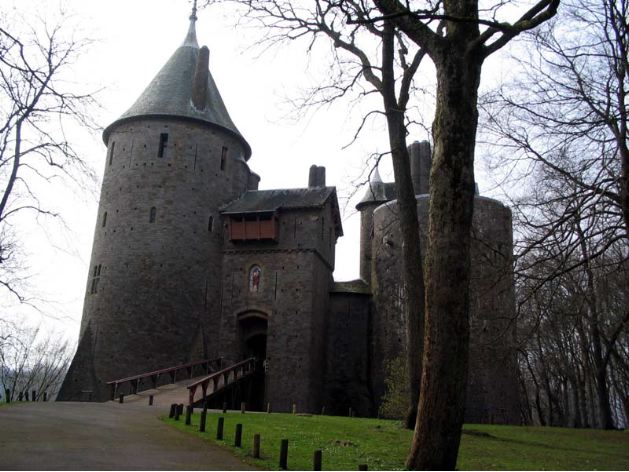
Not a real castle, this was a summer retreat for the immensely wealthy Bute family. It was built in the 1870’s on the site of the original Castell Coch, which was a genuine medieval fortress. Reminding us of some Disney productions, it is highly decorated inside in a fabulously gaudy style.
Besides being rich, the man who commissioned this fanciful structure was quite a character. Well educated, Lord Bute had so many interests and fascinations, he might rightly be called a renaissance man, but at the same time he was an eccentric. His areas of expertise included history, archaeology, mysticism, philanthropy, heraldry, theology, and fluency in 21 languages! During his time at Oxford, he became increasingly interested in medievalism and also met another like-minded individual, William Burges. His spiritual and emotional immersion in the Middle Ages led to his conversion at age 21 to Roman Catholicism, a highly unusual decision at the time.
As an architect, William Burges was the perfect choice for Bute's incursion into castle-building. He shared Bute's enthusiasm for all things medieval and was an expert on architecture of the Middle Ages. We read that Burges even wore medieval attire at home and was often seen with a parrot perched on his shoulder!
From one castle to another, the more grandiose Cardiff Castle was designed and built a decade earlier by the same two men. This was the Bute family home, an ornate mansion rich in medieval images and decorated in the same flamboyant style. Encircled by a wall, Cardiff Castle has the downtown area on one side and a large, very attractive park on the other. Some travelers cannot resist being snapped inside the walls, especially with the castle keep for a backdrop.
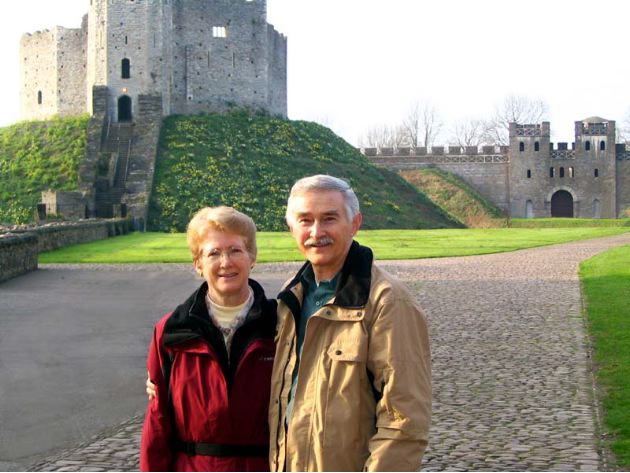
As the capital and largest city in Wales, Cardiff is a busy place although with a small town feel. Its population is around 330,000 and rather than reaching for the sky, it tends to sprawl. The docks in Cardiff Bay (which created the Bute family wealth through coal exportation) are a mile away from downtown. This area is being reinvented as an upscale commercial, dining and entertainment area. There, you can’t miss the Wales Millennium Centre.
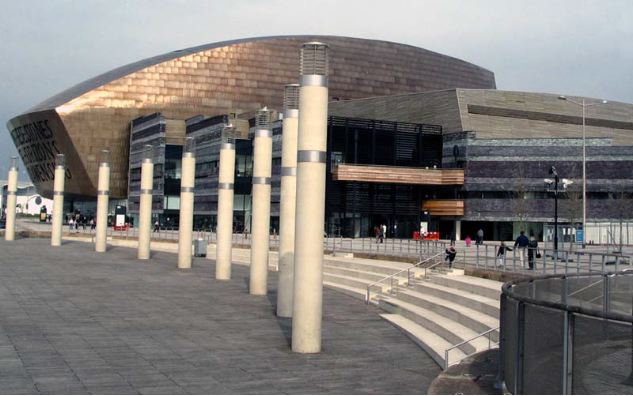
This multimedia arts center houses opera, theater and dance productions and more. The spectacular lobby is just as impressive as the exterior.
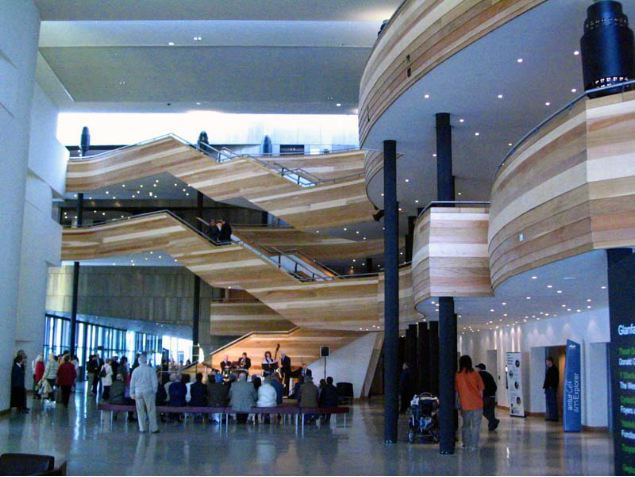
The other prominent Cardiff landmark impossible to miss is the Millennium Stadium, a huge, hulking sports complex in downtown that is host to the Rugby World Cup. It was constructed BEFORE the Millennium Centre, a fact that may hold a clue to Welsh priorities.
Our most enjoyed Cardiff attraction was the Museum of Welsh Life, an open-air museum sprawled over 100 acres of pretty Welsh countryside. Rescued buildings of all sorts from all over Wales have been moved here and re-erected to show how Welsh people lived at various times in history. Buildings include a school, chapel, bake shop, wool mill, iron workers’ cottages, blacksmith shop, cooper’s shop, general store and much more. There’s even a recreated Celtic village and a castle on the grounds plus livestock and poultry. The buildings are staffed by craftspeople eager to educate any curious visitors. I really liked the slate-cutters house because it fit so well my expectations for a traditional Welsh house.
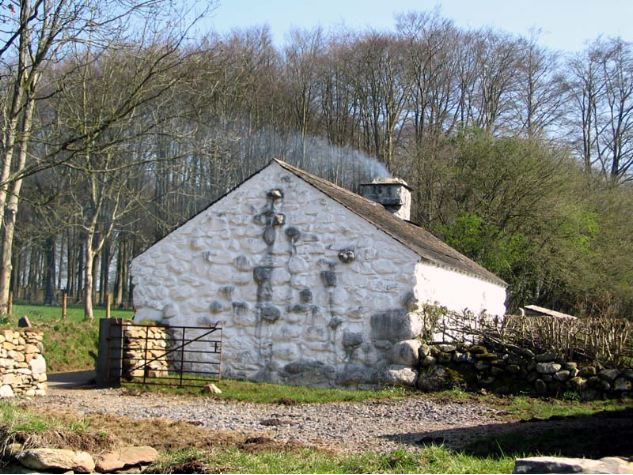
Before reaching one of our prime destinations, the Pembrokeshire coast, we drove through Swansea and out onto the Gower Peninsula. Of the many beauty spots around here, we chose to walk two of the beaches: Oxwich and Rhossili.
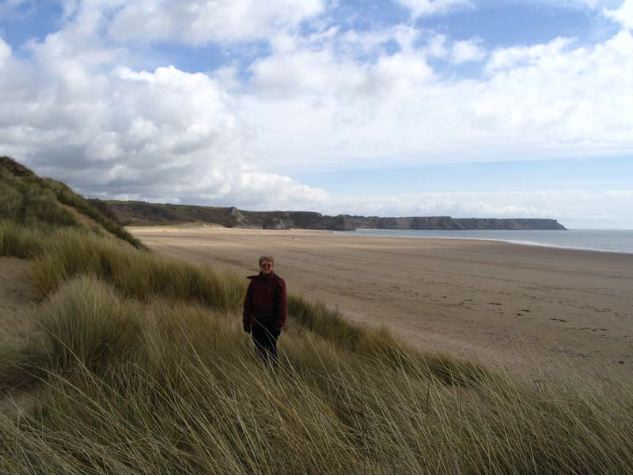
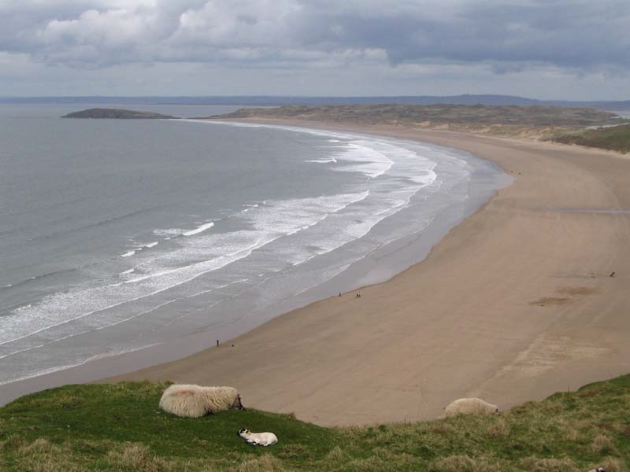
In Pembrokeshire we stayed in Solva, three miles from St David’s. Solva is a little village with a well-protected harbor, making it popular with sailors.

This was the base for our three-day tour of Pembrokeshire. There are, however, so many fascinating sights in this area, we could have happily stayed much longer. One of the UK’s most treasured walking routes, the Coastal Path alone runs for 186 miles!
Attractive Tenby is typical of the larger seaside towns in Pembrokeshire.

Heavily populated and abuzz in summer, we found it sedate and serene off season. In the summertime, boat trips to nearby islands are a favored activity. One such island is a sanctuary for seals and sea birds, another is home for a community of about 20 Cistercian monks. (Obviously, they must have open house.)
West of Tenby, smack on the Coastal Path, is splendid Barafundle Bay, once privately owned by the Campbell family.
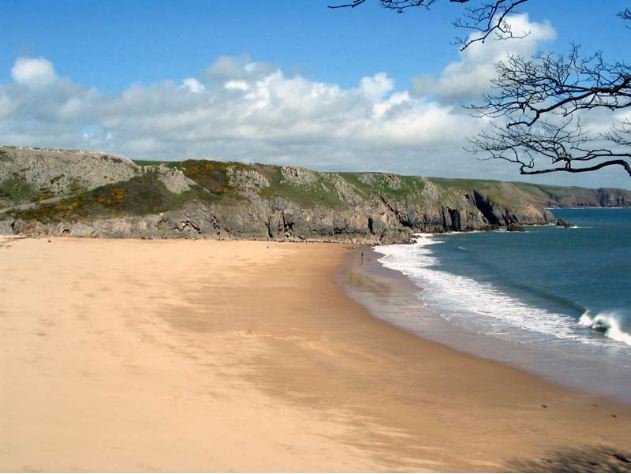
As part of a long circular walk from the family’s one-time estate, we had the pleasure of walking the length of Barafundle Beach. It is superb! No wonder to us it has earned the accolade of “the most beautiful beach in Britain”.
Other than that short stretch across Barafundle Beach, you may wonder what it’s like to walk the Pembrokeshire Coastal Path. Since we hiked only a small part of the total length, however, we can only give you some samples and, for that, photos work best:
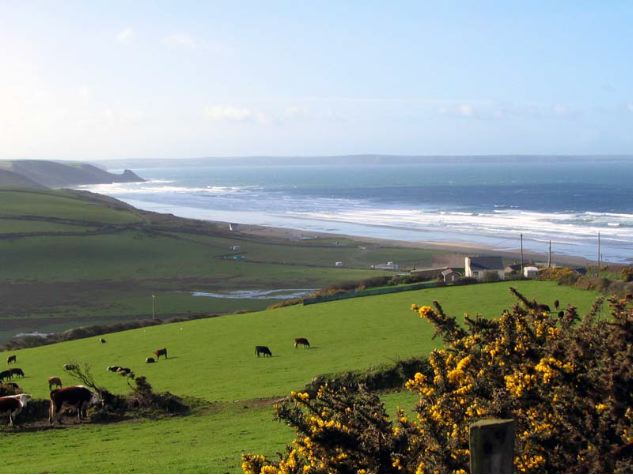
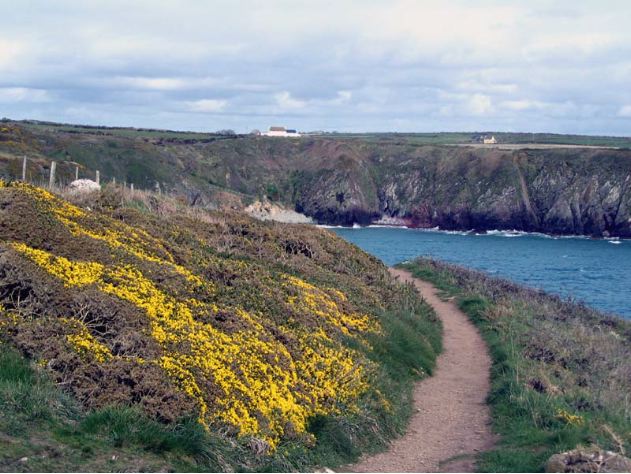
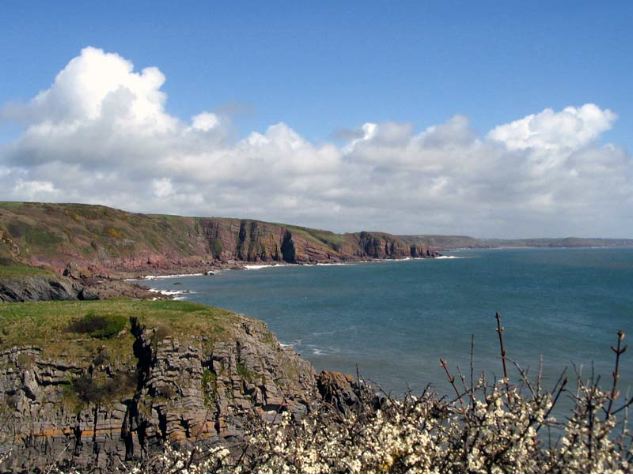
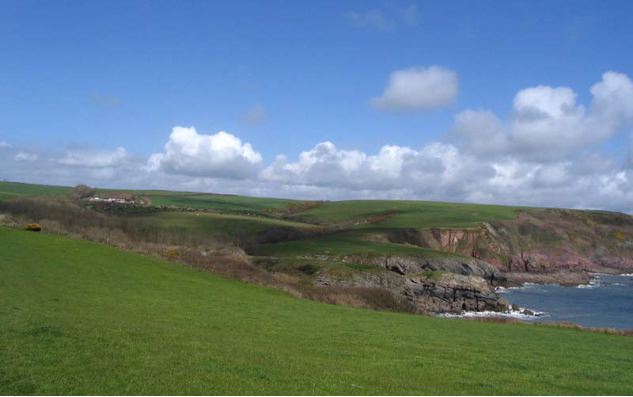
Leaving Pembrokeshire, we headed up the Welsh coast, stopping in New Quay. The tide was out; nevertheless, I thought these temporarily stranded boats made for an interesting composition:
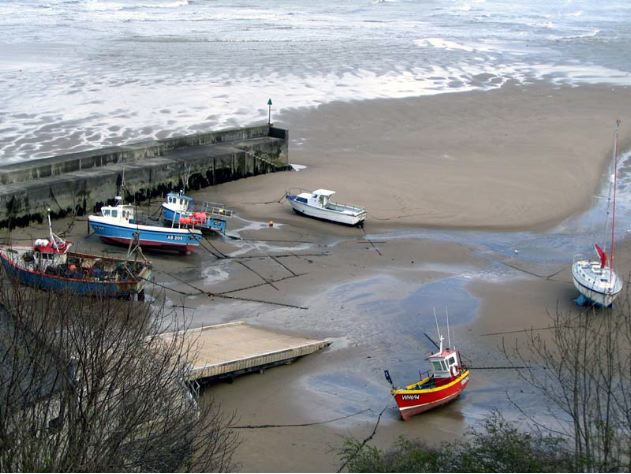
Farther north, we whiled away a few happy hours in Aberystwyth.
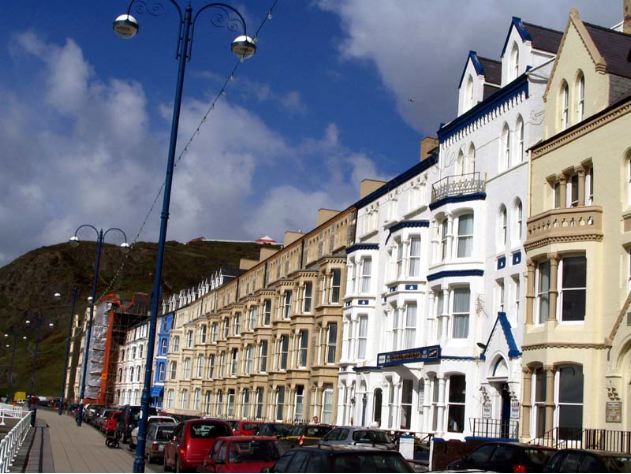
We enjoy seaside promenades wherever we find them and Britain has many. This attractive town offers a lengthy, seafront promenade, a top-heavy pier with a cheery amusements arcade and a homey museum of local history elegantly housed in a former theater.
Portmeirion would certainly have to be among the highlights of our trip.
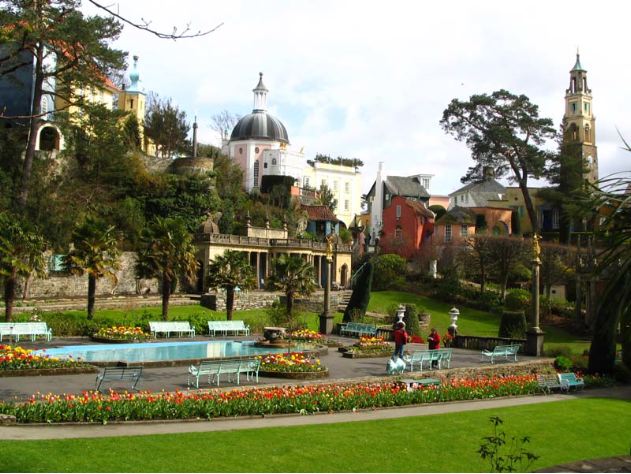

A final shot of Wales --- so very typical --- shows the old stone bridge in Llanwrst on a moody afternoon.
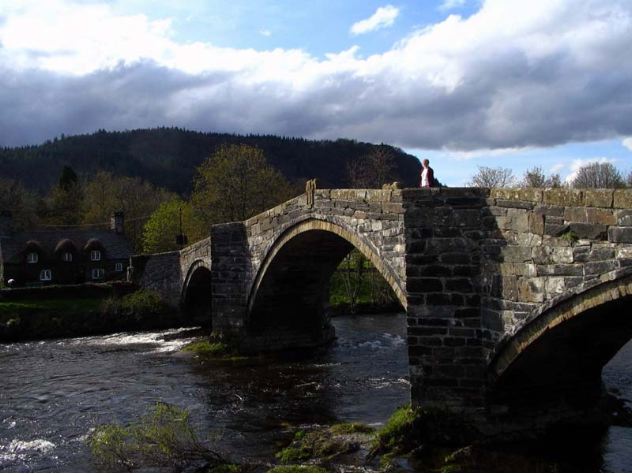
And, yes, that’s Patty surveying the view.
Wrapping up our trip, we returned to Yorkshire, England, for a five day stay in Harrogate, our home for more than three years. I can't resist including this one shot taken enroute near a canal-side cafe in Yorkshire.
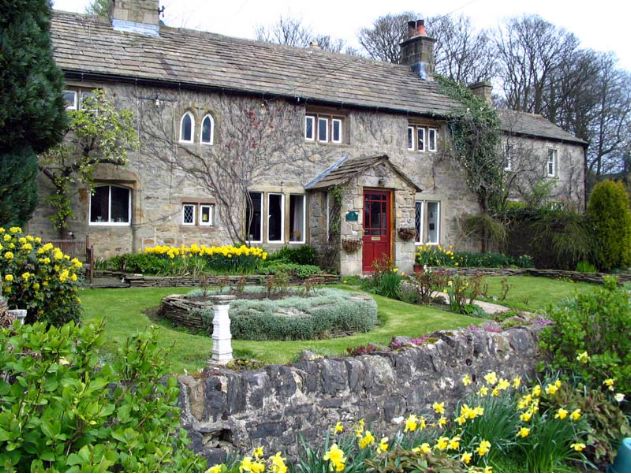
No question, friends are a blessing. We caught up with some of ours by either stopping by for tea, going out for dinner or meeting them at a dance. One whole day --- and a wonderful one at that --- was spent in the company of two dear British friends and former neighbors --- wandering through gardens and driving aimlessly around the dales, admiring the rolling green fields, stone walls, streams, flowers, farms and towns. Lucky us, we saw the Yorkshire Dales at their best as that was the sunniest day of the week.
Before heading for home, Patty and I even had time to get reacquainted with two of our favorite places, the historic old city of York and beautiful Fountains Abbey.
And, so, another long trip comes to a safe and satisfying end. Somehow, our meandering route added 1400 miles to the rental car, most of them in Wales. Unlike our normal routine, Patty drove every one of those miles, patiently and carefully, even though we could both legally drive. Having pored over the maps before we left, I was a natural choice for navigator, a nearly fulltime occupation on most British roads.
A few vivid memories will stay with us a long time: despite chilly winds, hardy Welsh kids playing on the beach dressed as if the temperature were in the 90’s; narrow winding roads bordering green, green fields filled with ewes and their cavorting lambs; Pembrokeshire’s outstanding beaches and scenic headlands; Portmeirion’s peacefulness; and, of course, the joy of just pottering about with old friends.